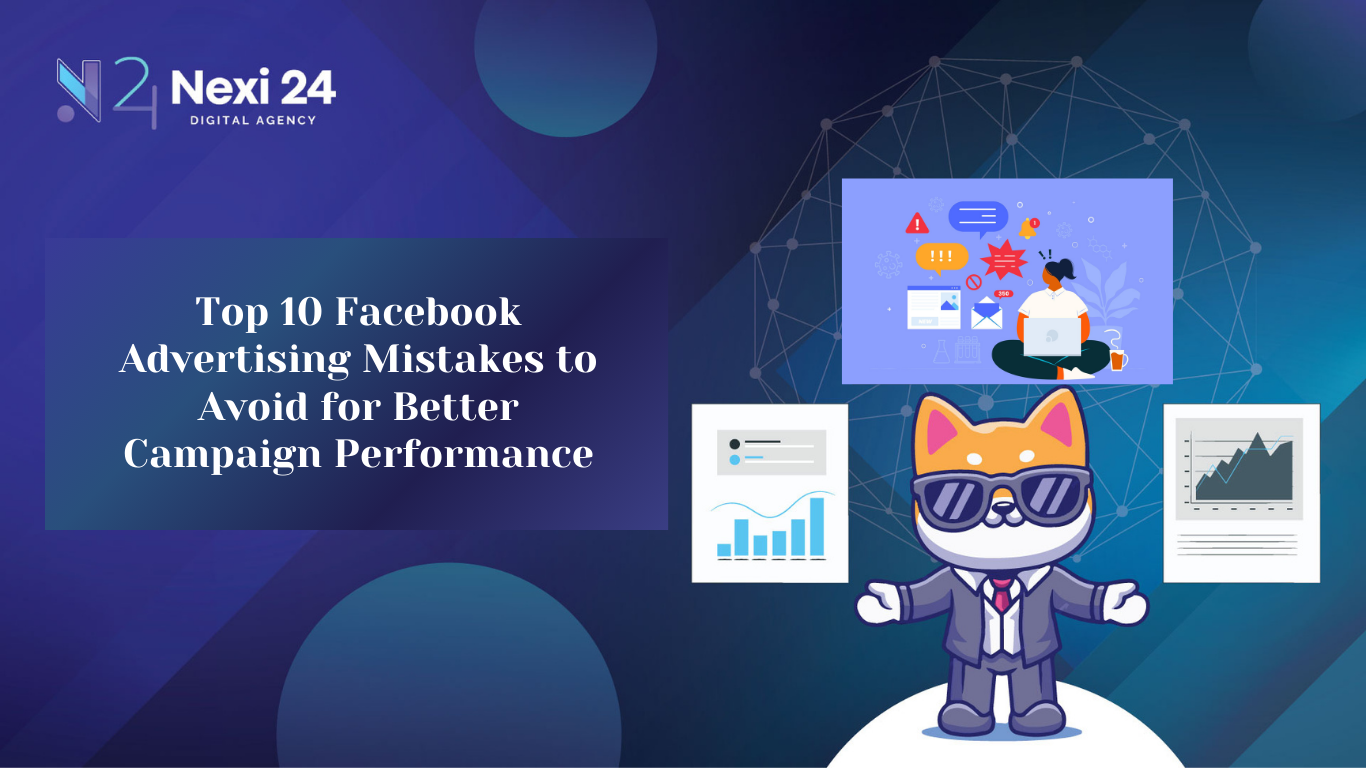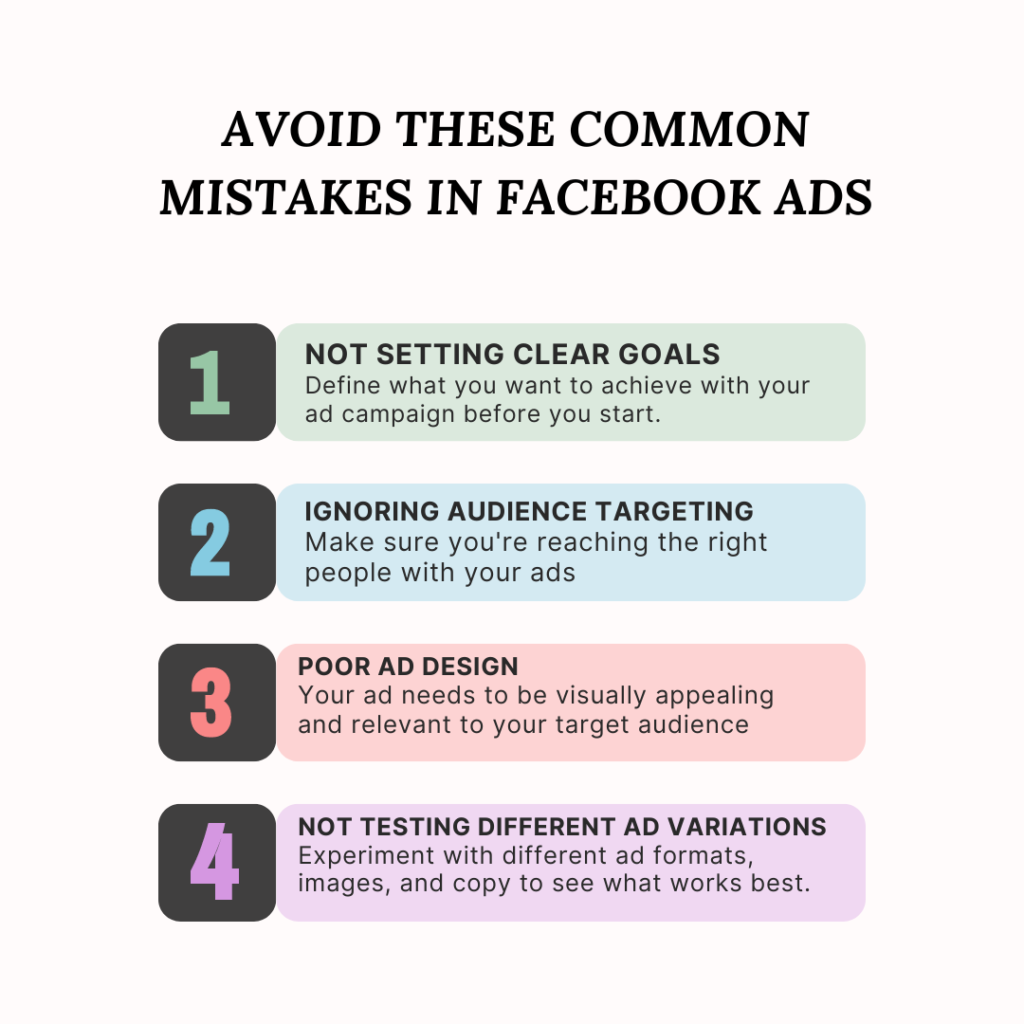Top 10 Facebook Advertising Mistakes to Avoid for Better Campaign Performance

Introduction
Facebook Advertising Mistakes can significantly impact the success of your campaigns. By understanding and avoiding these common pitfalls, you can enhance your ad performance, increase engagement, and maximize your return on investment. In this comprehensive guide, we’ll delve into the most prevalent mistakes and provide actionable tips to avoid them.
1. Inadequate Audience Targeting
The Mistake: One of the most critical aspects of Facebook advertising is targeting the right audience. Many advertisers either cast too wide a net or focus too narrowly, resulting in ineffective ad delivery.
How to Avoid It:
- Research Your Audience: Utilize Facebook Insights and other analytical tools to gain a deep understanding of your audience’s demographics, interests, and behaviors.
- Create Detailed Buyer Personas: Develop comprehensive profiles of your ideal customers to inform your targeting strategies.
- Utilize Custom Audiences: Use data from your existing customers or website visitors to create Custom Audiences, ensuring your ads reach relevant individuals.
- Continuous Testing: Regularly test different audience segments and adjust based on performance data.
2. Poor Ad Creatives
The Mistake: Even with precise targeting, poor ad creatives can lead to low engagement and poor performance. Bland visuals and uninspiring copy fail to capture attention in a crowded newsfeed.
How to Avoid It:
- High-Quality Visuals: Use high-resolution images and videos that are visually appealing and relevant to your message.
- Compelling Copy: Write concise, engaging copy that highlights the benefits and features of your offering. Use clear calls to action (CTAs) to guide users.
- A/B Testing: Experiment with different headlines, images, and CTAs to identify what resonates best with your audience.
- Stay On-Brand: Ensure your ad creatives align with your brand’s voice and aesthetic to maintain consistency.
3. Ignoring Ad Frequency
The Mistake: Showing the same ad to the same audience too frequently can lead to ad fatigue, where users become annoyed or indifferent to your message.
How to Avoid It:
- Monitor Frequency: Regularly check the frequency metric in your ad reports to see how often your ads are being shown to the same users.
- Rotate Creatives: Refresh your ad creatives regularly to keep your content fresh and engaging.
- Use Frequency Caps: Set frequency caps in your ad settings to limit how often your ads are shown to individual users.
- Diversify Ad Formats: Experiment with different ad formats, such as carousel ads, video ads, and slideshow ads, to provide variety.
4. Overlooking Mobile Optimization
The Mistake: With a significant portion of Facebook users accessing the platform via mobile devices, failing to optimize ads for mobile can result in a poor user experience and lower engagement.
How to Avoid It:
- Mobile-Friendly Designs: Ensure your ad creatives are visually appealing and easy to read on smaller screens.
- Quick Loading Times: Use Facebook’s Instant Experience ads or ensure your landing pages are optimized for fast loading on mobile devices.
- Responsive Layouts: Design your ads and landing pages to be responsive, adjusting seamlessly to different screen sizes.
- Test on Mobile Devices: Always preview and test your ads on various mobile devices before launching.
5. Skipping the Learning Phase
The Mistake: Facebook’s algorithm needs time to learn and optimize your ad delivery for the best results. Many advertisers make changes too quickly, disrupting this learning phase.
How to Avoid It:
- Patience is Key: Allow your ads to run for a sufficient period (typically 3-7 days) before making significant changes.
- Monitor but Don’t Micromanage: Keep an eye on your ad performance, but avoid making hasty adjustments that reset the learning phase.
- Gradual Changes: When making adjustments, do so gradually to allow the algorithm to adapt without starting over.

6. Underutilizing Facebook Pixel
The Mistake: The Facebook Pixel is a powerful tool that tracks user behavior and conversions, but many advertisers fail to install or utilize it effectively.
How to Avoid It:
- Install the Pixel: Ensure the Facebook Pixel is installed on your website to track conversions, optimize ads, and build retargeting audiences.
- Set Up Custom Conversions: Define and track specific actions that are valuable to your business, such as purchases, sign-ups, or page views.
- Use Retargeting: Create retargeting campaigns to reach users who have previously interacted with your website or ads.
- Leverage Lookalike Audiences: Use data from your Pixel to create Lookalike Audiences, expanding your reach to users similar to your best customers.
7. Failing to Analyze and Adapt
The Mistake: Running Facebook ads without regularly analyzing performance data and making data-driven decisions can lead to missed opportunities and suboptimal results.
How to Avoid It:
- Regular Reporting: Set up regular reporting schedules to review key metrics such as click-through rates (CTR), conversion rates, and return on ad spend (ROAS).
- Identify Trends: Look for patterns and trends in your data to understand what’s working and what’s not.
- Continuous Improvement: Use insights from your data to optimize your campaigns continually. This could involve tweaking your targeting, adjusting your budget, or testing new creatives.
- Stay Updated: Facebook’s advertising platform evolves frequently. Stay informed about new features, best practices, and changes to the algorithm to keep your campaigns effective.
Mastering Facebook advertising involves not only creating effective ads but also analyzing data and adapting strategies based on insights gained from performance metrics. Regularly monitoring and optimizing your campaigns will help you stay ahead of the competition and achieve better results.
8. Mismanaging Budget Allocation
The Mistake: Improper budget allocation can result in overspending on underperforming ads or underfunding campaigns with high potential.
How to Avoid It:
- Set Clear Objectives: Define clear goals for your campaigns to guide budget allocation. Whether it’s brand awareness, lead generation, or sales, having clear objectives helps in distributing your budget effectively.
- Monitor Performance: Regularly review the performance of your ad sets and campaigns to identify where your budget is being best utilized.
- Allocate Wisely: Allocate more budget to high-performing ads and reduce spending on underperforming ones. Use Facebook’s automated rules to manage budget adjustments automatically based on performance metrics.
- Test Budgets: Experiment with different budget levels to see what works best for your campaign objectives.
9. Neglecting Seasonal Trends
The Mistake: Ignoring seasonal trends and events can lead to missed opportunities for engagement and sales.
How to Avoid It:
- Plan Ahead: Develop a content calendar that includes key holidays, events, and seasonal trends relevant to your business.
- Create Seasonal Content: Tailor your ad creatives and messaging to reflect current trends and events. Seasonal promotions, themed ads, and timely offers can drive higher engagement.
- Monitor Trends: Keep an eye on social media and industry trends to stay ahead of what’s currently resonating with audiences.
- Adjust Budgets: Allocate additional budget during peak seasons or around major events to capitalize on increased consumer activity.
10. Ignoring Ad Placement Options
The Mistake: Relying solely on automatic placements can sometimes lead to suboptimal results, as not all placements perform equally for every campaign.
How to Avoid It:
- Analyze Placement Performance: Review performance data for different placements such as Facebook News Feed, Instagram Stories, Audience Network, and Messenger.
- Manual Placement Selection: Based on performance data, manually select placements that deliver the best results for your specific campaign objectives.
- Test Different Placements: Regularly test different placements to discover new opportunities and optimize your ad delivery.
- Adjust Strategies: Tailor your ad creatives to fit the specific requirements and best practices of each placement.
Conclusion
Successfully navigating the world of Facebook advertising requires a strategic approach, attention to detail, and a willingness to learn and adapt. By avoiding these common mistakes—such as inadequate targeting, poor ad creatives, ignoring ad frequency, neglecting mobile optimization, disrupting the learning phase, underutilizing the Facebook Pixel, failing to analyze and adapt, mismanaging budget allocation, neglecting seasonal trends, and ignoring ad placement options—you can significantly enhance the effectiveness of your ad campaigns.
Remember, the key to successful Facebook advertising lies in continuous testing, optimization, and a deep understanding of your audience. Implement these tips in your next campaign, and you’ll be well on your way to achieving better engagement, higher conversions, and a more substantial return on your advertising investment.
For further insights and strategies on Facebook advertising, consider consulting resources like Neil Patel’s Ultimate Guide to Facebook Ads to stay ahead of the curve and maximize your advertising efforts.

